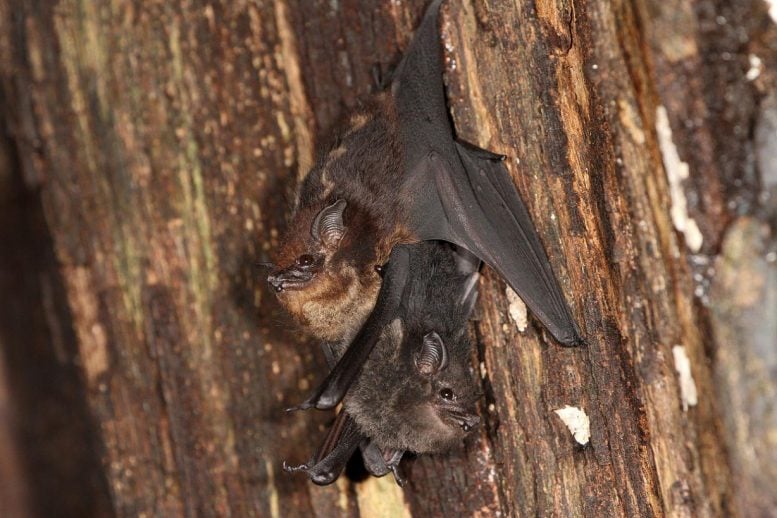
Mother-pup pair of the neotropical bat species Saccopteryx bilineata in the day-roost. The Pup is attached to the mother´s belly. Credit: Michael Stifter
More than anything else, language defines human nature. Speech, the vocal output of language, requires precise control over our vocal articulators, including the tongue, lips, and jaw. Every infant faces the challenge of gaining precise control over the vocal articulators to produce speech sounds. This control is gained during babbling when infants start to produce first utterances resembling speech sounds. Typical child development involves babbling, irrespective of the culture and language to be learned, and is thus characterized by universal features.
Much knowledge about human language acquisition is gained through comparative research on vocal ontogenetic processes in non-human animals, especially those capable of vocal imitation, one of the key components of human language. However, babbling behavior is rare in the animal kingdom; so far, this phenomenon has been described almost exclusively in songbirds. While research on songbirds has provided us with important insights about speech development in children, it is partly difficult to fully translate the results to humans because songbirds and humans differ anatomically — birds have a syrinx, we have a larynx — and in their brain organization.
Now there is one mammal, which at first sight holds very little resemblance to humans, and may seem rather unusual for comparative research on vocal development: the greater sac-winged bat Saccopteryx bilineata. Pups of this extraordinary bat species are capable of vocal imitation and engage in a conspicuous vocal practice behavior during ontogeny which strongly resembles human infant babbling.
A team of scientists from the Museum für Naturkunde Berlin, Ahana A. Fernandez, Lara S. Burchardt, Martina Nagy, and Mirjam Knörnschild, studied the babbling behavior of 20 pups in their natural habitat in Panama and Costa Rica. To collect data, the bats were habituated to the presence of the researchers in close vicinity of their roosts, thus allowing daily acoustic recordings and accompanying video recordings from birth until weaning (the point in time when mothers stop nursing their pups).
“Working with wild bat pups is a unique opportunity because it allows observing and recording a complex behavior in a completely natural undisturbed setting” explains Ahana Fernandez.
During their ontogeny, S. bilineata pups spend on average seven weeks engaging in daily babbling behavior. Pup babbling is characterized by long multisyllabic vocal sequences which include syllable types of the adult vocal repertoire.
“Pup babbling is a very conspicuous vocal behavior, it is audible at a considerable distance from the roost and babbling bouts have a duration of up to 43 minutes,” says Martina Nagy, “and while babbling, pups learn the song of the adult males.”
Back in Germany, the acoustic recordings were analyzed to investigate the characteristics of pup babbling. The researchers found that pup babbling is characterized by the same eight features as human infant babbling.
“For example, pup babbling is characterized by reduplication of syllables, similar to the characteristic syllable repetition — /dadada/ — in human infant babbling,” says Lara Burchardt. Moreover, pup babbling is rhythmic and occurs in both male and female pups – which stands in strong contrast to songbirds where only young males babble.
“It is fascinating to see these compelling parallels between the vocal practice behavior of two vocal learning mammals,” says Mirjam Knörnschild. “Our study is contributing to the interdisciplinary field of biolinguistics, which focuses on the biological foundations of human language to study its evolution.” Work on a vocal learning, babbling bat species may ultimately give us another piece of the puzzle to better understand the evolutionary origin of human language.
Reference: “Babbling in a vocal learning bat resembles human infant babbling” by Ahana A. Fernandez, Lara S. Burchardt, Martina Nagy and Mirjam Knörnschild, 20 August 2021, Science.
DOI: 10.1126/science.abf9279



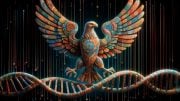
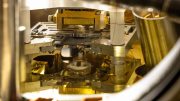
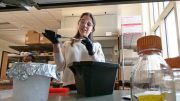

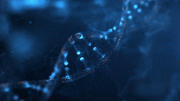
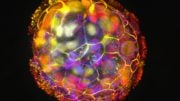
Babu G. Ranganathan*
(B.A. Bible/Biology)
OUR LIVING WORLD: NOT INVENTED BY NATURE
JUST BECAUSE something exists in nature does not mean it was invented by nature. If all the chemicals (i.e. amino acids, nucleic acids, etc.) necessary to make a cell were left to themselves, “Mother Nature” would have no ability to organize them into a cell. It requires an already existing cell to bring about another cell. The cell exists and reproduces in nature but nature didn’t invent or design it! Nature didn’t originate the cell or any form of life. An intelligent power outside of nature had to be responsible.
Miller, in his famous experiment in 1953, showed that amino acids (the building blocks of life) could form by chance. But, it’s not enough just to have amino acids. The various amino acids that make-up life must link together in a precise sequence, just like the letters in a sentence, to form functioning protein molecules. It has never been shown that various amino acids can bind together into a sequence by chance to form protein molecules.
Natural laws may explain how an airplane or cell works, but it’s not rational to believe that undirected natural laws can bring about an airplane or a cell.
ONCE YOU HAVE a complete and living cell then the genetic program (or code) and biological machinery exist to direct the formation of more cells, but how could the cell have originated naturally when no directing code and mechanisms existed in nature?
Mathematicians have said any event in the universe with odds of 10 to 50th power or greater is impossible! The probability of just an average size protein molecule arising by chance is 10 to the 65th power. Even the simplest cell is made up of many millions of various protein molecules along with and DNA/RNA..
The late great British scientist Sir Frederick Hoyle calculated that the odds of even the simplest cell coming into existence by chance is 10 to the 40,000th power! How large is this? Consider that the total number of atoms in our universe is 10 to the 82nd power.
The cell didn’t evolve. A partially evolved cell would quickly disintegrate, not wait millions of years to become complete and living.
WHAT ABOUT EVOLUTION? Only evolution within “kinds” is genetically possible (i.e. varieties of dogs, cats, horses, cows, etc.), but not evolution across “kinds” (i.e. from sea sponge to human). How could species have survived if their vital tissues, organs, reproductive systems were still evolving? Survival of the fittest would actually have prevented such evolution! Only limited evolution, variations of already existing genes and traits, is possible. Nature is mindless and has no ability to design and program entirely new genes for entirely new traits.
WHAT ABOUT NEW SPECIES: Although new species have come into existence, they don’t carry any new genes. They’ve become new species only because they can’t be crossed back with the original parent stock for various biological reasons. A biological “kind” allows for new species but not new genes. Nature has no ability to invent new genes for new traits. Only limited variations and adaptations are possible in nature, and all strictly within a biological “kind” (i.e. varieties of dogs, cats, etc.).
All species of plants and animals in the fossil record are found complete, fully formed, and fully functional. This is powerful evidence that all species came into existence as complete and fully formed from the beginning. This is only possible by creation.
What about natural selection? Natural selection doesn’t produce biological traits or variations. It can only “select” from biological variations that are possible and which have survival value. That’s why it’s called natural “selection.” The real issue is what biological variations are possible, not natural selection. Only variations and mutations of already existing genes or traits are possible.
Dr. Randy J. Guliuzza’s extensive research points to a better explanation than natural selection for variation and adaptation in nature. Dr. Guliuzza explains that species have pre-engineered mechanisms that enable organisms to continuously track and respond to environmental changes with system elements that correspond to human-designed tracking systems. This model is called CET (continuous environmental tracking). His research strongly indicates that living things have been pre-engineered to produce the right adaptations and changes required to live in changing environments. It’s much like a car that’s been pre-engineered so that the head lights turn on automatically when day changes to night.
Modern evolutionists believe and hope that over, supposedly, millions of years, random mutations in the genetic code caused by environmental radiation will generate entirely new genes for natural selection to use. This is total blind and irrational faith on the part of evolutionists. It’s much like believing that randomly changing the sequence of letters in a romance novel, over millions of years, will turn it into a book on astronomy! That’s the kind of blind faith macro-evolutionists have.
Mutations are accidents in the genetic, are mostly harmful, and have no capability of producing greater complexity in the code. Even if a good accident occurred, for every good one there would be hundreds of harmful ones with the net result, over time, being harmful, even lethal, to the species. Even if a single mutation is not immediately harmful, the accumulation of mutations over time will be harmful. At best, mutations only produce further variations within a natural species. Most biological variations are not due to mutations but from new combinations of already existing genes.
What about genetic and biological similarities between species? Genetic information, like other forms of information, cannot happen by chance, so it is more logical to believe that genetic and biological similarities between all forms of life are due to a common Designer who designed similar functions for similar purposes. It doesn’t mean all forms of life are biologically related! Only genetic similarities within a natural species proves relationship because it’s only within a natural species that members can interbreed and reproduce.
The actual similarity between ape and human DNA is between 70-87% not 99.8% as commonly believed. The original research stating 99.8% similarity was based on ignoring contradicting evidence. Only a certain segment of DNA between apes and humans was compared, not the entire DNA genome.
All the fossils that have been used to support human evolution have been found to be either hoaxes, non-human, or human, but not non-human and human (i.e. Neanderthal Man was discovered later to be fully human).
There has never been unanimous agreement among evolutionary scientists on ANY fossil evidence that has been used to support human evolution over the Many years, Including LUCY.
Also, so-called “Junk DNA” isn’t junk. Although these “non-coding” segments of DNA don’t code for proteins, they have recently been found to be vital in regulating gene expression (i.e. when, where, and how genes are expressed, so they’re not “junk”).
Read the author’s Internet article, NO MEAT-EATING ANIMALS EXISTED IN THE BEGINNING
Visit my latest Internet site: THE SCIENCE SUPPORTING CREATION (This site answers many arguments, both old and new, that have been used by evolutionists to support their theory)
Author of popular Internet article, TRADITIONAL DOCTRINE OF HELL EVOLVED FROM GREEK ROOTS
* I have had the privilege of being recognized in the 24th edition of Marquis “Who’s Who In The East” for my writings on religion and science, and I have given successful lectures (with question and answer time afterwards) defending creation from science before evolutionist science faculty and students at various colleges and universities.
Yeah, right.
Hmmmm… nope.
Ha! BS in it’s finest multisyllabic form. BTW, most people PAY to have their name in various Who’s Who publication. How much did Babu pay I wonder?
Absolutely we were created… AND we evolved (& are still evolving & creating). No one can support pure evolutionism after seriously comparing all of the facts & probabilities of it. If you look at the facts, probabilities & learn a little about quantum mechanics, the probability that we were created by some type of intelligent being(s) far outweighs pure evolutionism. People need to stop arguing about “either” & “or” & start considering “both”, with a middle man to assist…